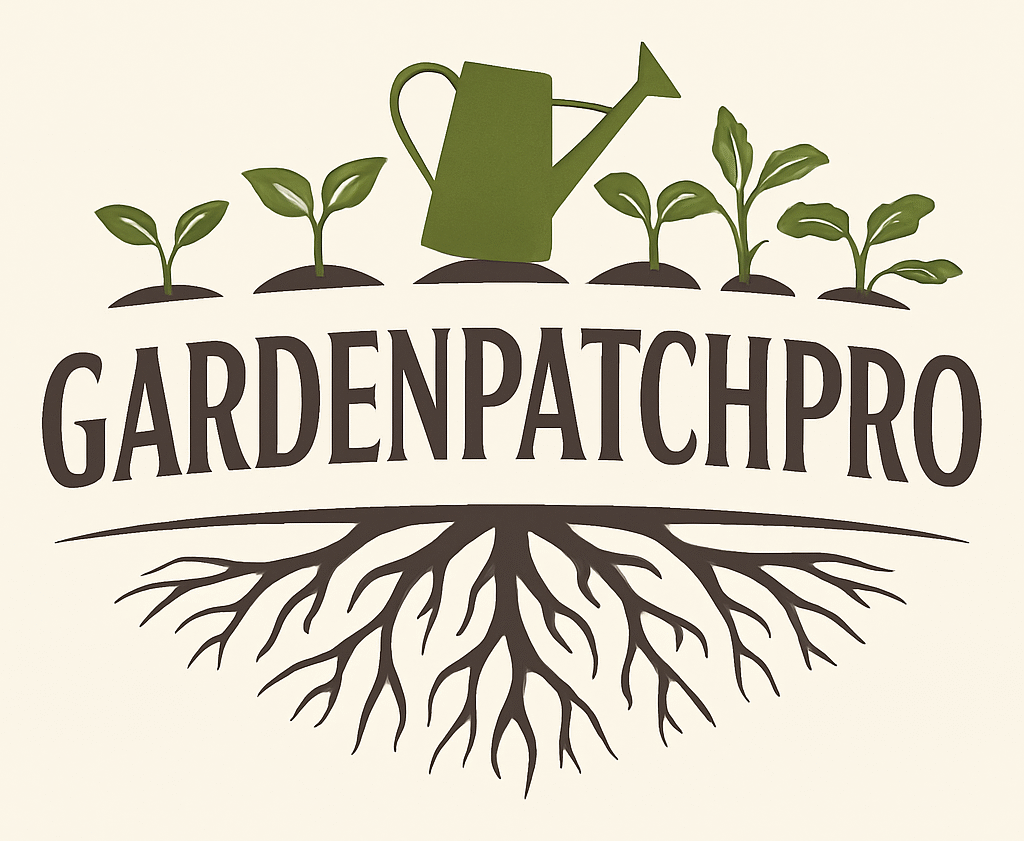10 Tranquil Garden Design Ideas for Creating a Peaceful Outdoor Space
Creating a tranquil garden design is a way to turn outdoor spaces into peaceful retreats. Many people seek calm and relaxation through their gardens, using natural elements and thoughtful layouts to achieve this effect. A well-designed tranquil garden can offer a quiet place to unwind and connect with nature.
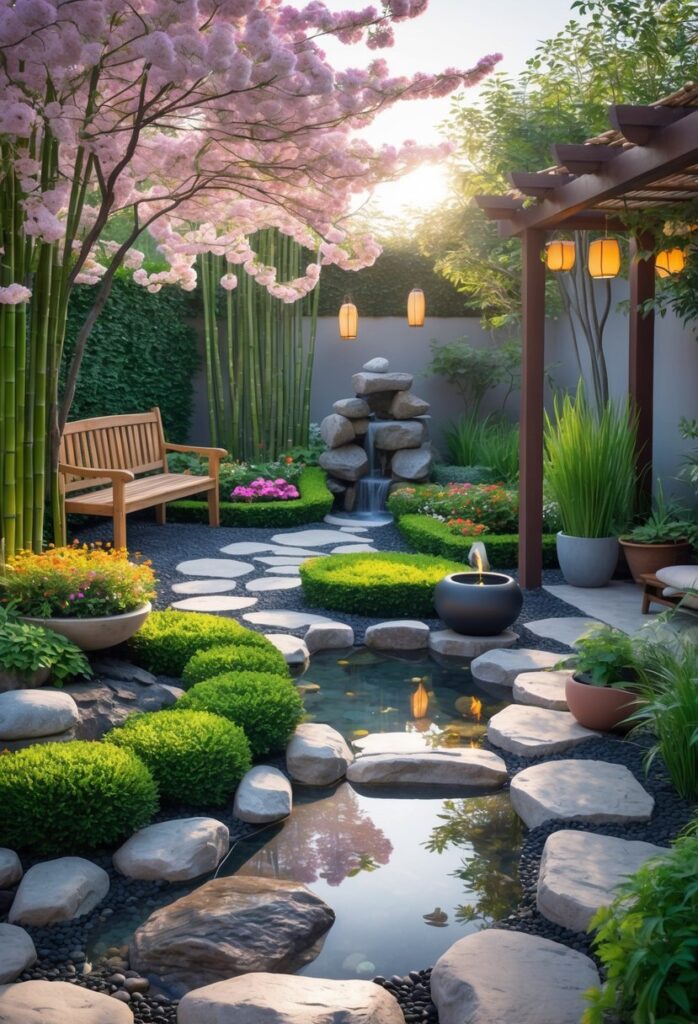
The key to a peaceful garden is combining simplicity, balance, and soothing features that promote calmness. This article highlights 10 ideas that help anyone create a garden space focused on serenity and comfort. These ideas work for different types of gardens, whether small or large, making tranquility accessible to many.
1) Peaceful gravel and stone layout for texture and calm
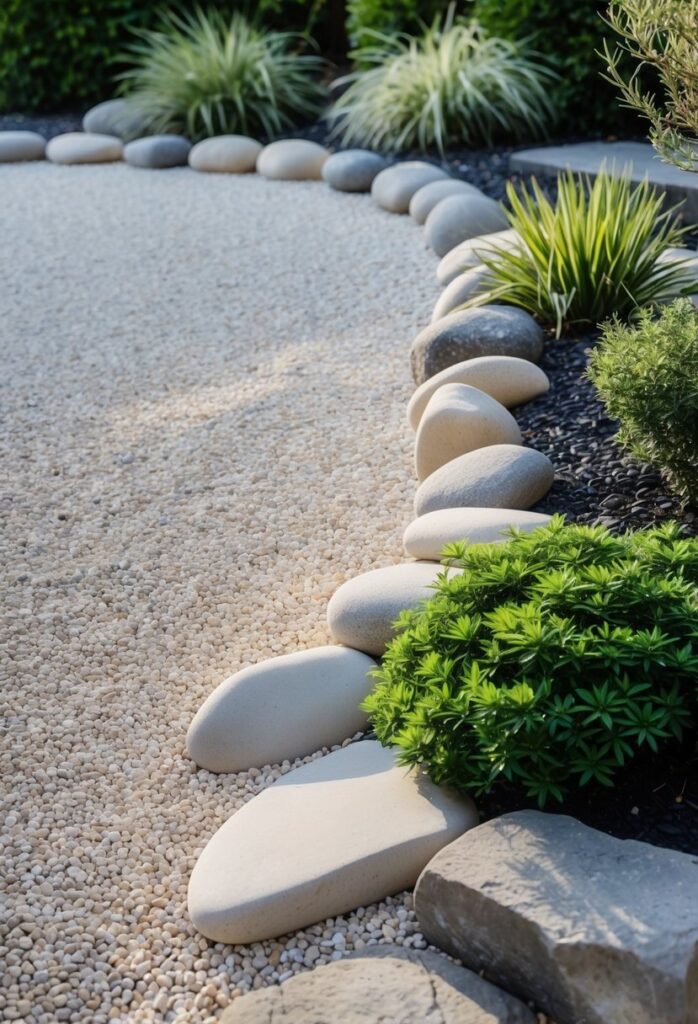
A peaceful gravel and stone layout creates a simple, natural look that helps bring calm to any garden. The mix of gravel and smooth stones adds texture, making the space feel balanced and quiet.
Using curved paths in the gravel can soften the garden’s appearance. These gentle lines guide the eye and create a smooth flow through the area.
Adding soft moss or small plants between stones introduces a touch of green, which warms the design. This contrast between hard and soft elements helps maintain a peaceful atmosphere.
Careful placement of each stone is important. It should feel natural but intentional, avoiding clutter or overcrowding.
For ideas on combining these elements, a guide on peaceful gravel and stone layout offers examples that enhance tranquility through texture and pattern.
2) Incorporate a koi pond with gentle water sounds

Adding a koi pond brings a sense of calm to any garden. The soft sounds of flowing water help create a peaceful atmosphere that encourages relaxation.
Careful design can enhance the pond’s natural look. Using stones of different shapes and sizes to border the pond adds texture and visual interest. Incorporating plants around the edges makes the space feel more connected to nature.
Water features like small waterfalls or fountains increase the soothing sound. The gentle trickle of water is known to reduce stress and improve the mood of people nearby.
Koi ponds also offer a living element with colorful fish that move slowly and gracefully. Watching koi swim can be a quiet, meditative experience.
To see ideas for combining water sounds and natural materials in garden ponds, visit 15 koi pond ideas that promise pure tranquility.
3) Use curved pathways to create a natural flow

Curved pathways help create a calm and inviting garden. They guide visitors gently through the space, making the journey feel more relaxed than a straight path.
These paths often mimic nature’s shapes, blending well with plants and natural materials. This can make the garden feel more harmonious and balanced.
Using materials like stone or gravel adds texture and interest. Spaces between stepping stones can be filled with grass or moss to soften edges and blend the path into the garden.
Plants along the curves add color and depth. Layered planting with varied heights enhances visual appeal and draws attention to different garden areas.
Curved pathways also open up surprise views. As the path turns, new sections of the garden come into view, encouraging exploration and a sense of discovery.
For ideas on creating these smooth, natural walkways, see curved walkway inspiration from diycraftsy.com.
4) Add bamboo fencing for privacy and Eastern aesthetic
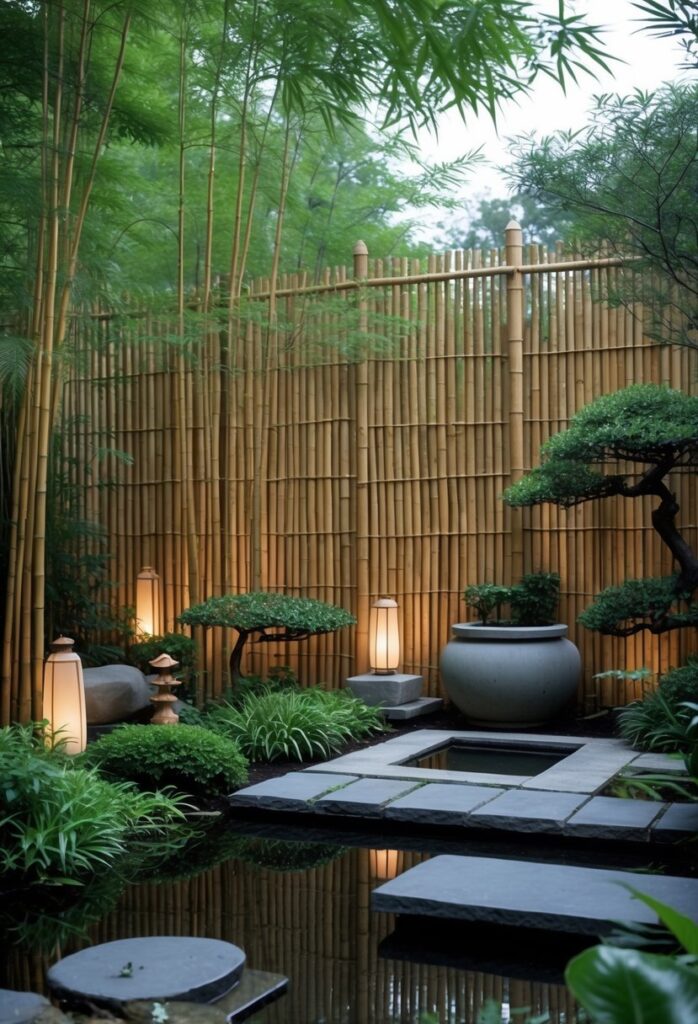
Bamboo fencing offers a natural way to create privacy in a garden. It blocks views from neighbors while adding a calming, Eastern-inspired look. This style fits well with Zen or minimalist garden designs.
The material is lightweight but strong, making installation easier. Bamboo panels come in different heights, so choices allow for varying levels of privacy.
Bamboo also absorbs sound, helping to reduce noise from nearby streets. Pairing bamboo fencing with stone or plants enhances the natural feel and adds texture.
Using bamboo complements gardens that focus on simplicity and tranquility. It blends well with water features, gravel paths, and green plants.
For more ideas about bamboo fencing that blends privacy and beauty, explore options like layered fences or bamboo trellis panels for climbing plants. These designs are both functional and visually pleasing. Details can be found in guides about bamboo fence ideas for privacy and aesthetics and bamboo garden fence ideas.
5) Create a small meditation spot with seating
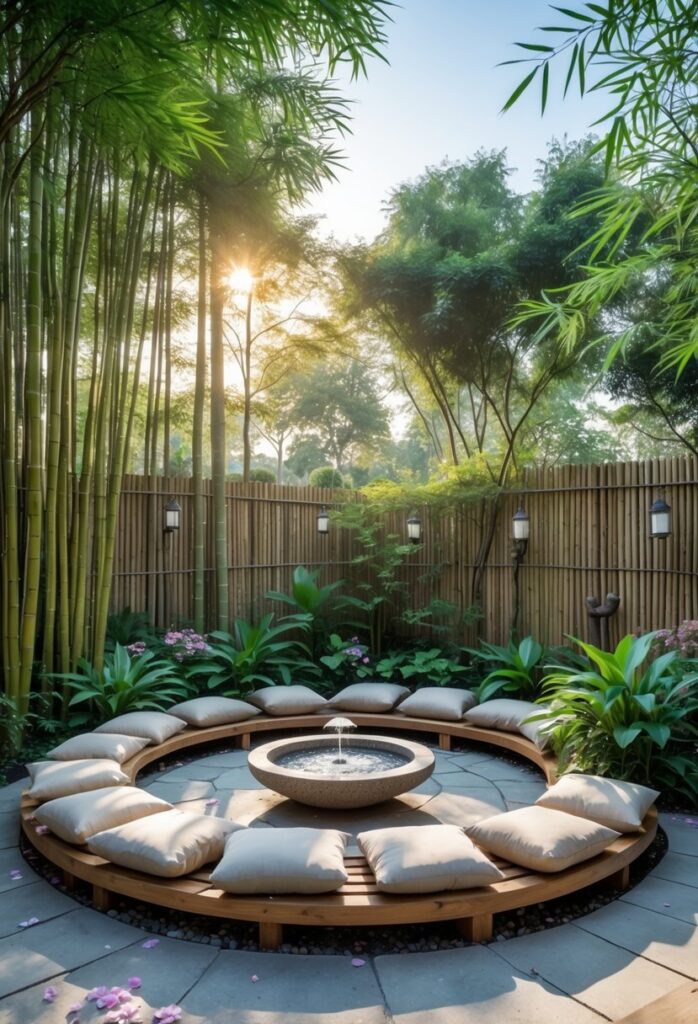
A small meditation spot with comfortable seating can offer a quiet place for daily reflection. It can be as simple as a bench, a few cushions, or a low chair placed in a calm corner of the garden.
Adding smooth stones or a soft ground cover like moss around the seating area can enhance the peaceful feeling. The space should feel private and inviting, helping to separate it from busier parts of the garden.
Incorporating natural elements like plants or a small water feature nearby can improve focus and relaxation. Soft lighting, such as an outdoor lantern, can make the spot usable in the evening without disturbing the calm atmosphere.
This small meditation space does not require a large area. Even a few square feet can be enough to create a private retreat for mindfulness and calm. Creating this in the backyard can bring a daily chance to pause and unwind in nature.
For more ideas on how to design a seating area for meditation, see 16+ inspiring tranquility garden ideas.
6) Use succulents and moss for low-maintenance greenery
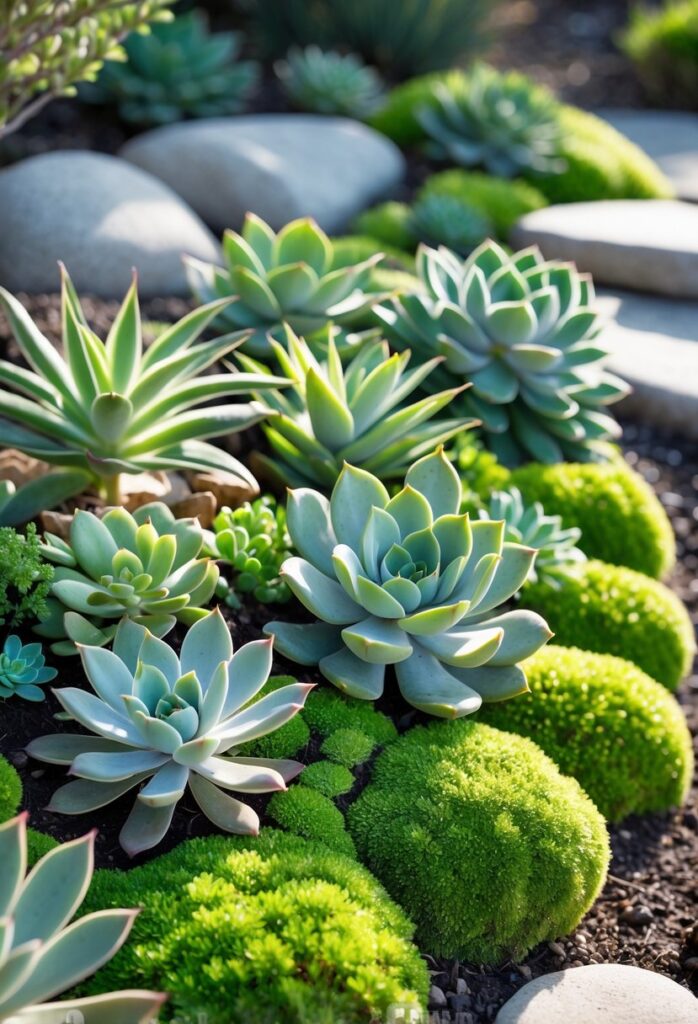
Succulents are a smart choice for a tranquil garden because they need little water and care. They come in many shapes and textures, adding visual interest without extra work. Mixing varieties like Aeoniums and leatherpetal succulents can create a balanced and attractive look.
Moss complements succulents well by bringing a soft, green touch to shady areas. It grows slowly and requires minimal upkeep, making it perfect for paths or shaded garden corners. Moss also helps retain moisture in the soil, benefiting nearby plants.
Together, succulents and moss form a peaceful, low-maintenance garden space. They reduce the need for frequent watering and trimming, saving time while keeping the area lush. This combination fits well for those who want beauty with less effort.
For more ideas on using succulents and moss, explore creative garden layouts and tips for low-maintenance greenery. These plants provide a calming vibe that suits both indoor and outdoor spaces without demanding much attention. For more ideas, see succulent garden designs with moss elements.
7) Install soft landscape lighting for evening tranquility
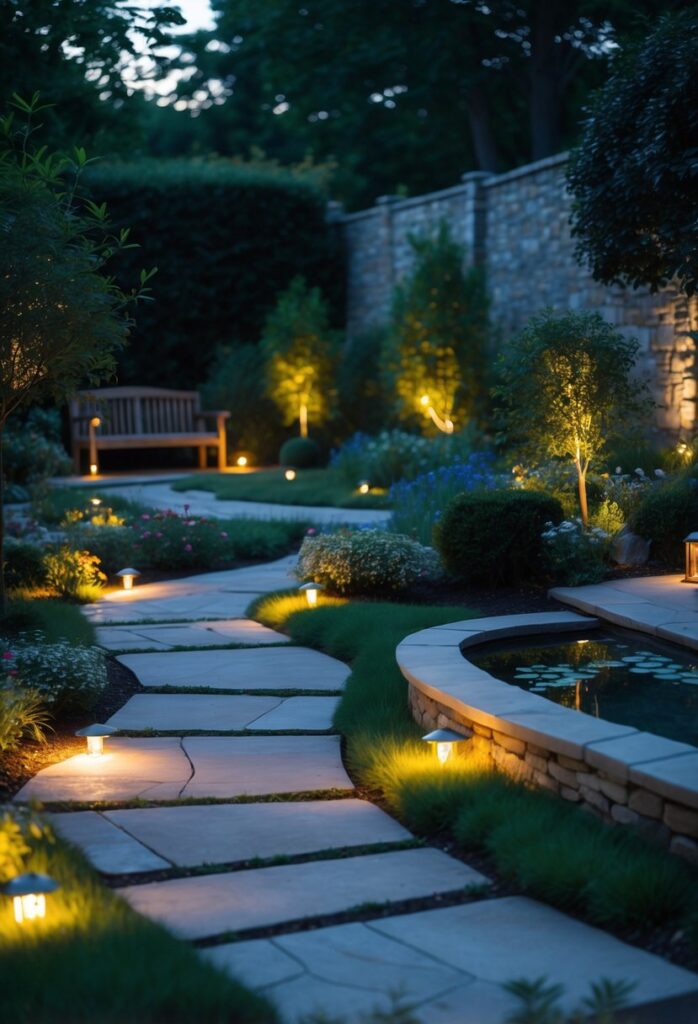
Soft landscape lighting helps create a calm and peaceful atmosphere in the garden after dark. It gently lights pathways, plants, and seating areas without being too bright or harsh. This kind of lighting encourages relaxation and quiet enjoyment of the outdoor space.
Using warm-toned bulbs adds a cozy glow that feels inviting. Layering different light sources, such as low ambient lights and focused accent lights, can highlight key features like trees or water elements. This balance enhances the natural beauty without overwhelming the senses.
Choosing fixtures that blend with the garden’s style keeps the lighting subtle and meaningful. Properly placed lights also improve safety by showing where people walk. Well-planned soft lighting turns the garden into a serene place for evening meditation or socializing.
For ideas on how to design lighting that supports evening relaxation, see landscape lighting for evening gardens.
8) Introduce rock gardens with raked gravel patterns
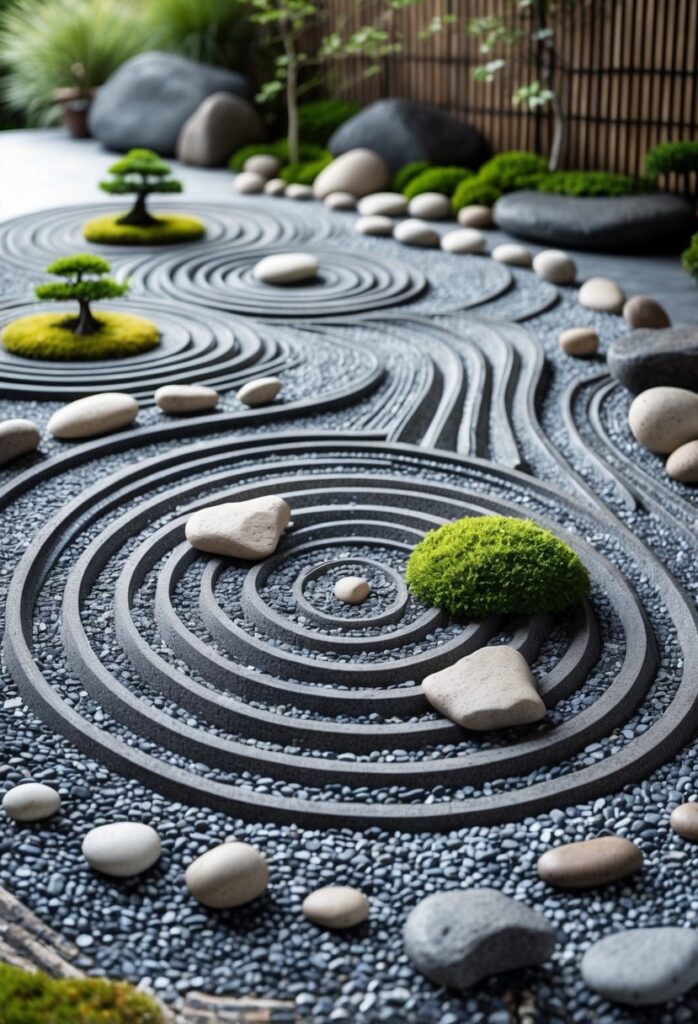
Rock gardens with raked gravel bring a calm and simple beauty to outdoor spaces. The fine gravel is carefully shaped into patterns that often look like ripples or waves. These designs help create a peaceful atmosphere.
The gravel acts like water, while large rocks represent islands or mountains. This mix promotes a sense of balance and order. The patterns can be changed regularly, offering a relaxing, meditative activity.
Using mostly natural colors like white or soft gray gravel supports a minimalist look. Adding moss or small plants can soften the hard surfaces without cluttering the space.
This type of garden works well in small or large areas, making it flexible for different needs. For ideas on layouts and raked gravel, one can explore examples of Zen rock gardens with raked gravel.
9) Plant fragrant herbs like lavender or jasmine

Fragrant herbs such as lavender and jasmine add both scent and beauty to a garden. Lavender is well-known for its calming floral aroma that stays in the air, making outdoor spaces more inviting.
Jasmine offers a sweet, exotic fragrance that can fill the garden, especially in the evening. Both plants are relatively easy to grow and fit well near patios or walkways.
Lavender prefers full sun and well-drained soil to thrive. It also helps repel some pests, making it practical as well as decorative.
Jasmine grows best in warm conditions and can climb structures like trellises, adding vertical interest. These scented herbs create a peaceful atmosphere that enhances the overall garden experience.
Choosing fragrant herbs like these improves a garden’s sensory appeal without requiring much extra care. Growing combinations of herbs can also provide layers of scent throughout different times of the year.
More tips on using fragrant plants can be found in this guide to fragrant herbs for a relaxing garden experience.
10) Include a Japanese maple for seasonal color
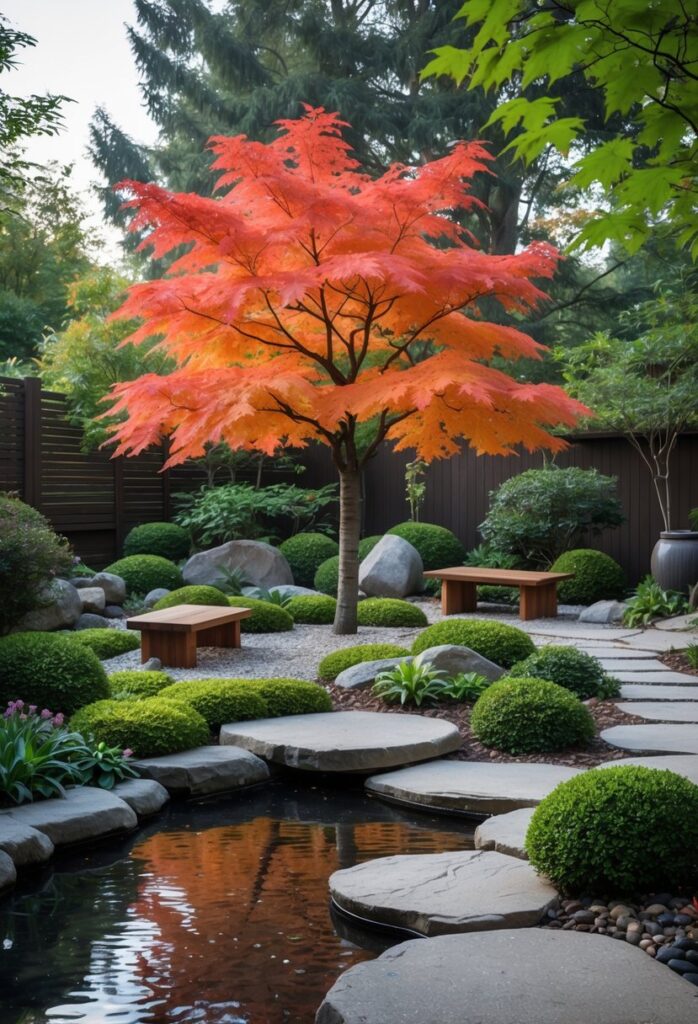
A Japanese maple adds calm and beauty to any garden. Its delicate leaves change color with the seasons, offering shades of red, orange, and yellow in the fall. This seasonal shift creates natural interest throughout the year.
The tree’s elegant shape fits well in many garden styles. It can serve as a focal point because of its unique form and vibrant colors. Japanese maples work well in small or large spaces, adding texture and charm.
They are also versatile. Some varieties are small enough for containers, while others grow into striking specimens. Including a Japanese maple can bring balance and a sense of peace to a garden design.
For ideas on using them effectively, exploring Japanese maple garden design ideas can provide simple ways to enhance outdoor spaces with this beautiful tree.
Principles of Tranquil Garden Design
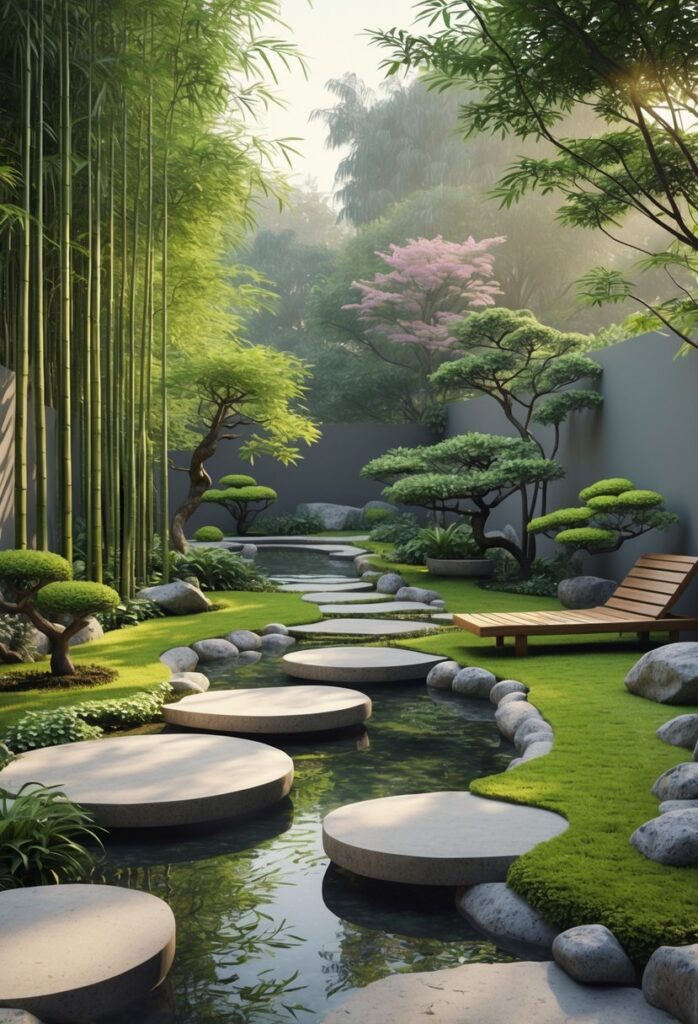
Tranquil garden design focuses on creating a space where every element works together smoothly. Key ideas include achieving visual balance and choosing colors that calm the senses. These principles make the garden feel peaceful and inviting.
The Importance of Balance and Harmony
Balance in a garden means arranging plants, paths, and features so they feel evenly spread. It can be symmetrical, where both sides match, or asymmetrical, with different elements balanced by size or color.
Harmony happens when the materials and shapes connect naturally. Using natural stones, wood, and soft textures helps the garden look unified. The goal is for no part to feel out of place or overpower the others.
Keeping paths wide enough and seats comfortable adds to the calm feeling. Proper spacing and grouping plants so they don’t crowd each other also support harmony. This makes the garden easy to move through and enjoy fully.
Selecting Soothing Color Palettes
Soft, natural colors work best in a tranquil garden. Shades of green, blue, and earth tones like beige and brown create a relaxing atmosphere. Bright or clashing colors can break the calm mood.
Using color in layers—such as green leaves as a base with gentle flower colors—keeps the space peaceful. White or pale flowers add light without overwhelming the eyes.
It is helpful to limit the number of colors to create a consistent look. This simplicity helps visitors focus on nature itself, not distractions. Lighting also affects how colors appear, so warm, soft light enhances soothing tones.
Choosing calming colors supports the feeling of rest and peace throughout the garden.
For more ideas, see how color and balance come together in tranquil garden design.
Complementary Elements for a Serene Atmosphere
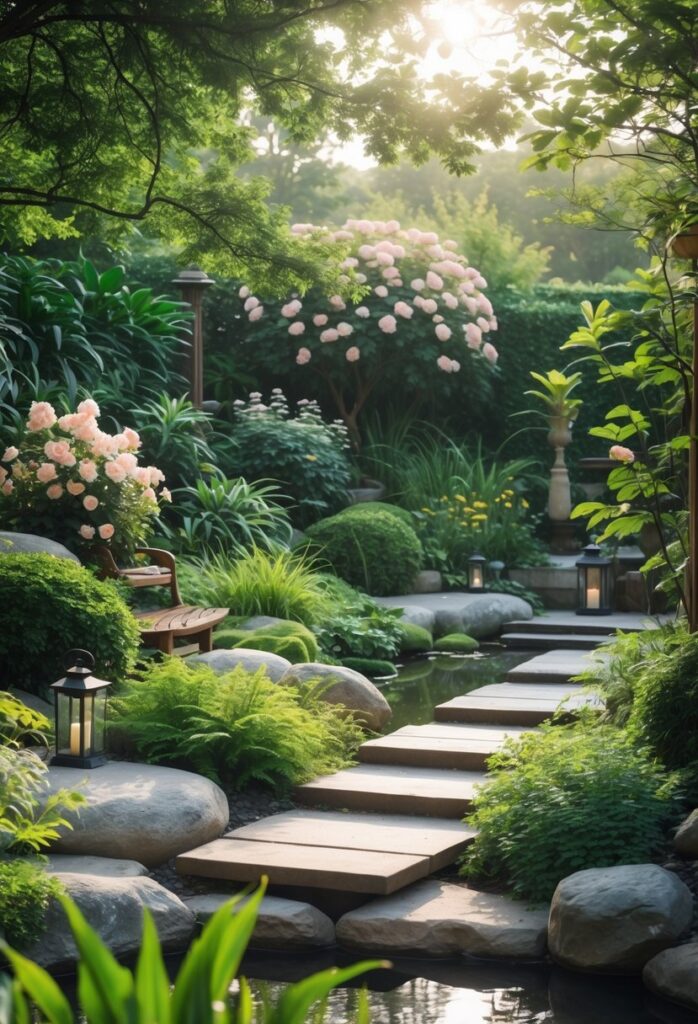
Creating a peaceful garden involves more than plants and layout. The use of water and lighting plays a key role in setting a calm mood. Carefully chosen features can enrich the space without overwhelming it.
Water Features and Their Calming Effects
Water features like fountains, small ponds, or waterfalls add a soothing sound that masks noise from nearby streets or neighbors. The gentle flow of water supports relaxation and helps to reduce stress.
When selecting a water feature, size and placement matter. A compact fountain suits small gardens or patios, while larger ponds fit open yards. Positioning near seating areas enhances enjoyment.
Maintenance is important; a clean, functioning feature keeps the garden inviting and serene. Adding natural materials like stones or aquatic plants around the water can increase the sense of calm.
Choosing Tranquil Lighting Solutions
Lighting should create a soft, inviting glow instead of harsh brightness. Using warm white LED lights or solar-powered fixtures helps maintain an eco-friendly approach.
Strategic placement of lights under trees, around paths, or near water features highlights these peaceful design elements. Low-level lighting reduces glare and encourages evening use without disturbing night vision.
String lights or lanterns add charm and encourage quiet gathering spots. Motion sensor lights can provide safety while minimizing constant brightness, preserving the garden’s restful atmosphere.
For more ideas on peaceful gardens, see 22 Garden Design Tricks to Instantly Create a More Peaceful Outdoor Space.
Frequently Asked Questions
Creating a tranquil garden involves smart choices about materials, plants, and space. Practical methods and design principles help turn any outdoor area into a calm retreat. Using simple layouts, natural textures, and quiet water features can greatly enhance the peaceful feel.
What are cost-effective strategies for creating a tranquil garden on a budget?
Using inexpensive materials like gravel and stones for paths and ground cover adds texture without high costs. Reusing items such as old pots or wood can reduce expenses. Planting native, low-maintenance plants lowers upkeep costs. Small water features that don’t require pumps can add calm without a big price.
How can small spaces be maximized to design a peaceful garden retreat?
Curved pathways create a sense of flow and space in tight areas. Vertical planting or wall-mounted elements save ground space. Adding bamboo fencing offers privacy while keeping the area open and natural. A small meditation spot with simple seating can fit even in limited yards.
What elements are essential for achieving tranquility in a garden design?
Balance in layout helps create harmony. Natural materials like stone, wood, and bamboo bring calm textures. Water features such as a koi pond provide soothing sounds. Green plants and flowers with subtle fragrance add gentle sensory appeal. Seating areas encourage rest and reflection.
Can you provide examples of tranquil garden designs that utilize recycled materials?
Old bricks or stones can be used for edging or stepping stones. Recycled wood makes good fencing or benches, supporting both function and style. Broken pottery pieces work well in mosaics for decoration. These materials help reduce waste while adding character to the garden.
What are some low-maintenance plants that contribute to a serene garden atmosphere?
Lavender and other fragrant herbs add soothing scents. Ferns provide lush, calming greenery with little care. Bamboo grows quickly and blocks noise, adding privacy. Succulents and ornamental grasses require minimal watering and upkeep while adding texture.
How do the principles of a Zen garden apply to designing a tranquil garden?
Zen gardens focus on simplicity, balance, and natural elements. Using gravel or sand raked into patterns creates a calm visual effect. Stones placed thoughtfully represent mountains or islands, enhancing harmony. Minimal plant use and clean lines reduce clutter and allow peaceful reflection.
For more ideas, see 10 garden design ideas turn your backyard into a charming oasis.
